New Stones and Old Stones: Narrating Turkey’s Past
June 28, 2008 at 8:03 am 2 comments
Yesterday it was Gallipoli, today Troy. The tour of Gallipoli took five hours, a very detailed recounting of landings and trenches, battles and bad judgment, famine and disease. The story was told by our Turkish tour guide with a remarkable focus on the British, Australian, and New Zealand forces that had struggled to take the Dardennelles in 1915. The narrative was about their plans, their decisions, their suffering, even their dead. We visited the Allied landing sites, the Allied cemeteries, the Allied memorials, and heard detailed accounts of annual Anzac Day celebrations.
When I found our guide standing alone at the Australian memorial, I couldn’t wait any longer. How do tour guides portray these events and monuments for Turks? I asked. Bülent, our guide (named after one of the chief leftist politicians of the 60s) insisted that he did not do tours for Turkish groups. I asked about what seemed to be a tremendous emphasis on and respect for Turkey’s enemies. He agreed, mentioning Ataturk’s famous quote now prominently displayed at the site. When I mused about whether Turkey might consider the same sort of memorial to Armenians, he deferred. He focuses on Galipoli, and can’t really contribute to the conversation on Armenians.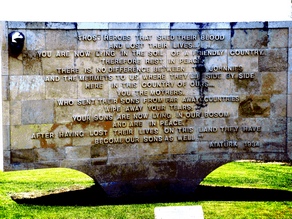
Bülent told me that there are different sites emphasized in tours for Turks, and over the past few years various municipalities had begun bringing busloads of religious Turks to Gallipoli for free tours.
Indeed, we saw Turks at only three of the 9 sites we visited. We saw them at the trenches, the tour stop that illustrated quite dramatically the proximity of the two groups of combatants: the trenches were very few meters apart. Our penultimate stop, a memorial to the Turkish dead, was quite crowded with Turkish busses (from Zetinburnu, Kacamustafapasa municipalities). Bülent explained that the government was trying to turn Galipoli into a pilgrimage site, a sacred space, because of the number of Turks who had died during the battles there. Indeed, the place has become an open-air mosque, complete with a fountain in the courtyard and a mihrab inside the inner walls.
Turks were also predominant at the highest site, where Mustafa Keml (Atatürk) had seen the Allied landings and urged his troops to great sacrifice in order to stop it. The Turkish tour guide was speaking to his audience in the shadow of an enormous statue of Atatürk.
In my Modern Middle East lectures, I often present Gallipoli as a prequel, Ataturk’s life before he took off his Ottoman uniform and joined the opposition to the Allies and the Sultan in 1918. According to many of the people we have spoken with, and a fascinating article by Esra Ozyurek, the renewed reification of Ataturk is largely a response to the growing power of Islamist politics. Although the five other fundamental principals of Kemalism may be eroding, secularism seems to be keeping center stage. Too bad I missed the photograph of the two high-school girls wearing the “turban” headscarves so offfensive to the Kemalists. They were leaving the area of the trenches using a Turkish flag as a shawl.

As the Fez bus wound its way from Çanakkale to Selçuk the next day, we stopped for tours of much older stones than those memorializing the World War I dead. First stop, Troy. Our tour guide provided a photo opportunity to see the Trojan Horse that Brad Pitt had touched (!), retold the mythology of the Illiad, and walked us through the myriad levels of “Troy.” He was more than a bit confusing, apparently unable to distinguish between myth and history, or even to comment on the extent to which myth had influenced our perceptions of history.
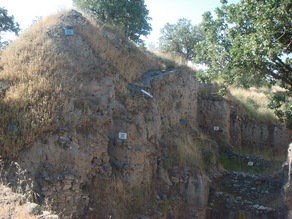
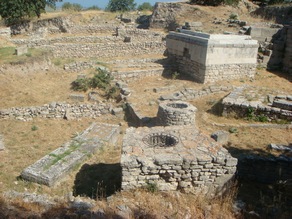
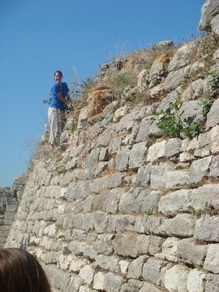
This was antiquarianism of stones, and some of his explanations seemed most unlikely. The high point of the stop was Zoe climbing the walls of Troy (the Turks don’t keep people off many of the ruins).
From Troy, to Bergama (Pergamum), another set of ruins, this one much more convincing. This was the only female tour guide I have seen in Turkey so far. She did a better job, at least explaining how the city had functioned, and where things were located. She paused for reasonable intervals to let us climb around.
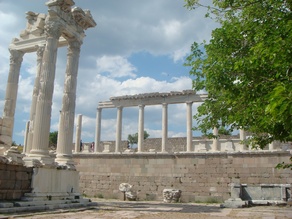

The views were awesome–it is located high on a hill–and the students immediately took to posing. They were particularly delighted with the columns, and decided to retake their “senior pictures” leaning on real pillars instead of the photographers’ substitutes in their home towns.
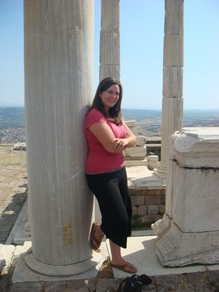

What had all these to do with “Turkish” identity? How do today’s Turks incorporate all these stones into their own collective memory? The only clues we had was a statue defining Homer as an “Anatolian.”
By the time we arrived in Selçuk, I realized that tour guides would not give us what we wanted. Stones are fascinating, but we wanted to know about who had built and lived in them.
Entry filed under: Ottoman, Teaching, Uncategorized.
2 Comments Add your own
Leave a comment
Trackback this post | Subscribe to the comments via RSS Feed

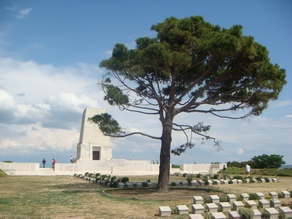

1. Brad Pitt Celebrity Gossip | New Stones and Old Stones: Narrating Turkey’s Past | June 30, 2008 at 5:08 am
[…] provided a photo opportunity to see the Trojan Horse that Brad Pitt had touched (!)… Source: New Stones and Old Stones: Narrating Turkey’s Past Who Would Be A Worse Mom? Paris or Lindsey? Vote Now And Get A Free iPhone. Brad Pitt Used This […]
2. sandrar | September 10, 2009 at 2:38 pm
sandrar | September 10, 2009 at 2:38 pm
Hi! I was surfing and found your blog post… nice! I love your blog. 🙂 Cheers! Sandra. R.